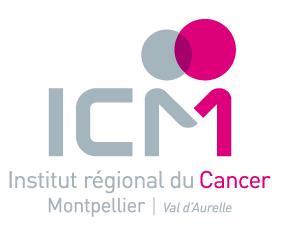Stereotactic MR-Guided Radiotherapy for Pancreatic Tumors: Dosimetric Benefit of Adaptation and First Clinical Results in a Prospective Registry Study
Résumé
Introduction Stereotactic MR-guided adaptive radiotherapy (SMART) is an attractive modality of radiotherapy for pancreatic tumors. The objectives of this prospective registry study were to report the dosimetric benefits of daily adaptation of SMART and the first clinical results in pancreatic tumors. Materials and Methods All patients treated in our center with SMART for a pancreatic tumor were included. Patients were planned for five daily-adapted fractions on consecutive days. Endpoints were acute toxicities, late toxicities, impact of adaptive treatment on target volume coverage and organs at risk (OAR) sparing, local control (LC) rate, distant metastasis-free survival (DMFS), and overall survival (OS). Results Thirty consecutive patients were included between October 2019 and April 2021. The median dose prescription was 50 Gy. No patient presented grade > 2 acute toxicities. The most frequent grade 1–2 toxicities were asthenia (40%), abdominal pain (40%), and nausea (43%). Daily adaptation significantly improved planning target volume (PTV) and gross tumor volume (GTV) coverage and OAR sparing. With a median follow-up of 9.7 months, the median OS, 6-month OS, and 1-year OS were 14.1 months, 89% (95% CI: 70%–96%), and 75% (95% CI: 51%–88%), respectively, from SMART completion. LC at 6 months and 1 year was respectively 97% (95% CI: 79–99.5%) and 86% (95% CI: 61%–95%). There were no grade > 2 late toxicities. With a median follow-up of 10.64 months, locally advanced pancreatic cancer (LAPC) and borderline resectable pancreatic cancer (BRPC) patients (22 patients) had a median OS, 6-month OS, and 1-year OS from SMART completion of 14.1 months, 76% (95% CI: 51%–89%), and 70% (95% CI: 45%–85%), respectively. Nine patients underwent surgical resection (42.1% of patients with initial LAPC and 33.3% of patients with BRPC), with negative margins (R0). Resected patients had a significantly better OS as compared to unresected patients (p = 0.0219, hazard ratio (HR) = 5.78 (95% CI: 1.29–25.9)). Conclusion SMART for pancreatic tumors is feasible without limiting toxicities. Daily adaptation demonstrated a benefit for tumor coverage and OAR sparing. The severity of observed acute and late toxicities was low. OS and LC rates were promising. SMART achieved a high secondary resection rate in LAPC patients. Surgery after SMART seemed to be feasible and might increase OS in these patients.
Mots clés
adaptive radiotherapy
borderline resectable pancreatic cancers
image guided radiotherapy (IGRT)
locally advanced pancreatic cancer
pancreatic cancer
pancreatic tumors
stereotactic MR-guided adaptive radiotherapy
stereotactic body radiation therapy
stereotactic MR-guided adaptive radiotherapy stereotactic body radiation therapy pancreatic cancer pancreatic tumors locally advanced pancreatic cancer borderline resectable pancreatic cancers adaptive radiotherapy image guided radiotherapy (IGRT)
Domaines
Cancer
Origine : Fichiers éditeurs autorisés sur une archive ouverte
licence : CC BY - Paternité
licence : CC BY - Paternité



